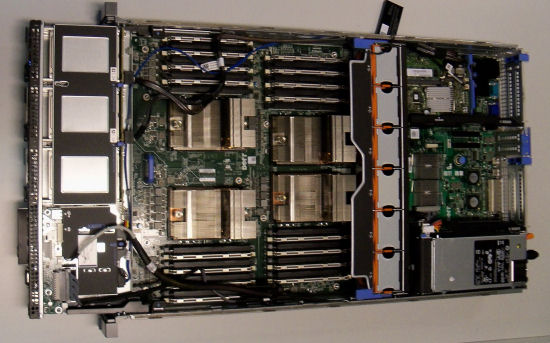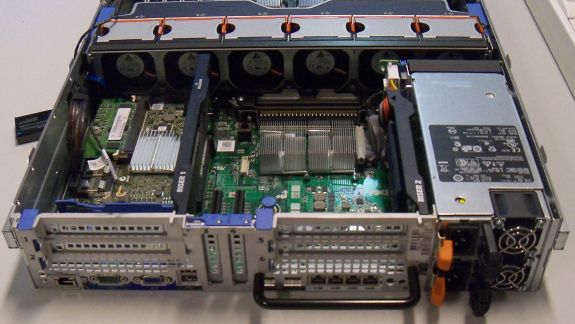Server Clash: DELL's Quad Opteron DELL R815 vs HP's DL380 G7 and SGI's Altix UV10
by Johan De Gelas on September 9, 2010 7:30 AM EST- Posted in
- IT Computing
- AMD
- Intel
- Xeon
- Opteron
Dell PowerEdge R815 Benchmarked Configuration
| CPU | Four Opteron 6174 at 2.2GHz |
| RAM | 16 x 4GB Samsung 1333MHz CH9 |
| Motherboard | Dell Inc 06JC9T |
| Chipset | AMD SR5650 |
| BIOS version | v1.1.9 |
| PSU | 2x Dell L1100A-S0 1100W |
The R815 is a very compact design: six fans in the middle of the chassis pull the cool air across the four Opteron socket and 32 DDR3 DIMM slots. Two risers offer two full height PCIe x8 slots each.
Two half-height PCIe x4 slots are also available. The server contains six drive bays, all in 2.5 inch format.

Click to enlarge

The DELL server line distinguishes itself with an LCD display that allows you to read system alerts and boot-up options. The dual internal SD modules are unfortunately still only 1GB and thus only suited for ESXi. The 1100W hot-pluggable PSU are the only available PSUs. The entire front with disk bays can slide forward to give easy access to the first row of CPU sockets and DIMM slots.
AMD and Dell also confirmed that you will be able to upgrade this server with the next generation "Bulldozer" CPUs.











51 Comments
View All Comments
jdavenport608 - Thursday, September 9, 2010 - link
Appears that the pros and cons on the last page are not correct for the SGI server.Photubias - Thursday, September 9, 2010 - link
If you view the article in 'Print Format' than it shows correctly.Seems to be an Anandtech issue ... :p
Ryan Smith - Thursday, September 9, 2010 - link
Fixed. Thanks for the notice.yyrkoon - Friday, September 10, 2010 - link
Hey guys, you've got to do better than this. The only thing that drew me to this article was the Name "SGI" and your explanation of their system is nothing.Why not just come out and say . . " Hey, look what I've got pictures of". Thats about all the use I have for the "article". Sorry if you do not like that Johan, but the truth hurts.
JohanAnandtech - Friday, September 10, 2010 - link
It is clear that we do not focus on the typical SGI market. But you have noticed that from the other competitors and you know that HPC is not our main expertise, virtualization is. It is not really clear what your complaint is, so I assume that it is the lack of HPC benchmarks. Care to make your complaint a little more constructive?davegraham - Monday, September 13, 2010 - link
i'll defend Johan here...SGI has basically cornered themselves into the cloud scale market place where their BTO-style of engagement has really allowed them to prosper. If you wanted a competitive story there, the Dell DCS series of servers (C6100, for example) would be a better comparison.cheers,
Dave
tech6 - Thursday, September 9, 2010 - link
While the 815 is great value where the host is CPU bound, most VM workloads seem to be memory limited rather than processing power. Another consideration is server (in particularly memory) longevity which is something where the 810 inherits the 910s RAS features while the 815 misses out.I am not disagreeing with your conclusion that the 815 is great value but only if your workload is CPU bound and if you are willing to take the risk of not having RAS features in a data center application.
JFAMD - Thursday, September 9, 2010 - link
True that there is a RAS difference, but you do have to weigh the budget differences and power differences to determine whether the RAS levels of either the R815 (or even a xeon 5600 system) are not sufficient for your application. Keep in mind that the xeon 7400 series did not have these RAS features, so if you were comfortable with the RAS levels of the 7400 series for these apps, then you have to question whether the new RAS features are a "must have". I am not saying that people shouldn't want more RAS (everyone should), but it is more a question of whether it is worth paying the extra price up front and the extra price every hour at the wall socket.For virtualization, the last time I talked to the VM vendors about attach rate, they said that their attach rate to platform matched the market (i.e. ~75% of their software was landing on 2P systems). So in the case of virtualization you can move to the R815 and still enjoy the economics of the 2P world but get the scalability of the 4P products.
tech6 - Thursday, September 9, 2010 - link
I don't disagree but the RAS issue also dictates the longevity of the platform. I have been in the hosting business for a while and we see memory errors bring down 2 year+ old HP blades in alarming numbers. If you budget for a 4 year life cycle, then RAS has to be high on your list of features to make that happen.mino - Thursday, September 9, 2010 - link
Generally I would agree except that 2yr old HP blades (G5) are the worst way to ascertain commodity x86 platform reliability.Reasons:
1) inadequate cooling setup (you better keep c7000 input air well below 20C at all costs)
2) FBDIMM love to overheat
3) G5 blade mobos are BIG MESS when it comes to memory compatibility => they clearly underestimated the tolerances needed
4) All the points above hold true at least compared to HS21* and except 1) also against bl465*
Speaking about 3yrs of operations of all three boxen in similar conditions. The most clear thi became to us when building power got cutoff and all our BladeSystems got dead within minutes (before running out of UPS by any means) while our 5yrs old BladeCenter (hosting all infrastructure services) remained online even at 35C (where the temp platoed thanks to dead HP's)
Ironically, thanks to the dead production we did not have to kill infrastructure at all as the UPS's lasted for the 3 hours needed easily ...